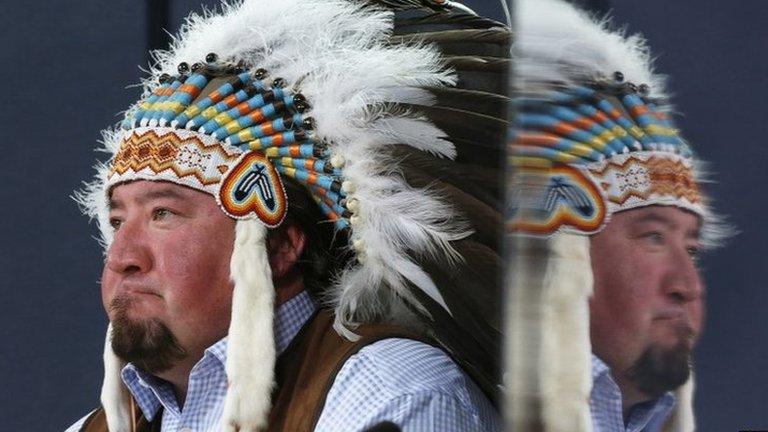Finding a solution to Canada's Indigenous water crisis
- Published
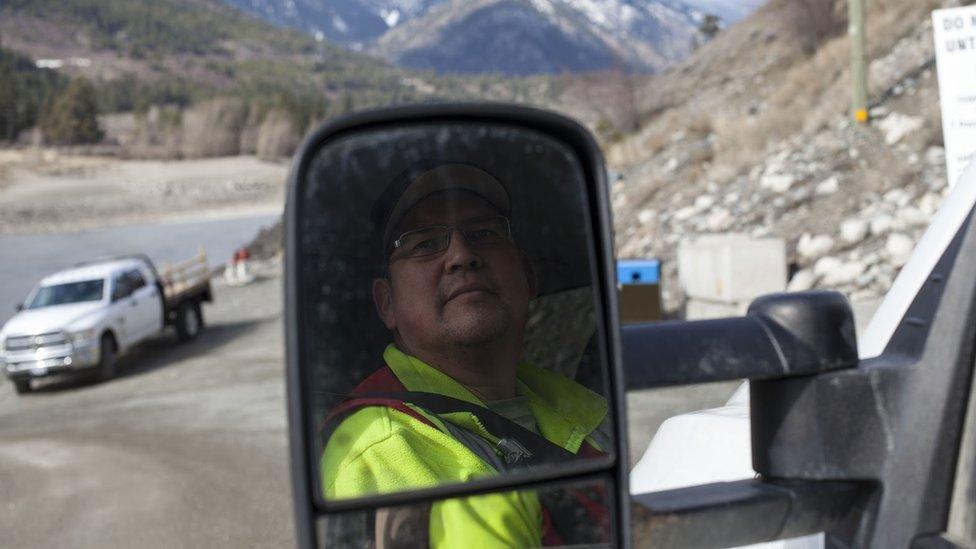
Lytton's water operator Warren Brown
Many First Nation communities across Canada have been under long-term boil water advisories. One community is trying some innovative solutions. Graduate students from the University of British Columbia report from Lytton, British Columbia. This project is in collaboration with the Global Reporting Centre.
Karen Dunstan lifts a large metal pot up to the sink and turns on the tap. The water is crisp, cold and clear, but it isn't clean.
When the pot is nearly full, she puts it on the stove to boil. Only then can she and her children have a drink.
For more than 20 years, this was part of her morning routine.
"You would have flu-like symptoms and have diarrhoea and vomiting from drinking the water [without boiling]," says Dunstan, 53. Like many in her community, she lived under a boil water advisory for decades.
Dunstan lives in Lytton First Nation, a rural on-reserve Indigenous community of 945 people in British Columbia, Canada's westernmost province.
Lytton is just one among hundreds of First Nations that have suffered from a water crisis in Canada.
Despite the fact that Canada has the world's third largest per-capita freshwater reserve, the water many Indigenous communities depend on is contaminated, difficult to access, or at risk due to faulty treatment systems.
Sorry, your browser cannot display this map
Nestled deep in the Fraser Canyon, the community of Lytton is centred around the confluence of two mighty waterways.
It's here the dark blue-green waters of the Thompson River mix and quickly disappear into the muddy-brown water of the Fraser, British Columbia's longest river.
A patchwork of 56 reserves spread over 14,161 acres, Lytton draws its water from these rivers and the creeks feeding into them.
But animal faeces and agricultural activity upstream release coliform bacteria such as E. Coli into the water, making it potentially unsafe to drink.
For years, residents resorted to buying bottled water or simply drank it untreated, which elders in the community link to a number of children's deaths.
"If you go to some of our reserves you almost wonder like, wow, isn't this the 21st Century? Why are they still living like that?" says Warren Brown, 45, the water operator at Lytton First Nation.
"It's like a third-world country sometimes."
A paramedic-turned-water operator, Brown is at the centre of Lytton's struggle for clean water.
He spends his days travelling across the reserve lands, inspecting and maintaining water treatment facilities. If an advisory needs to be issued, Brown is the one who makes the call.
Warren Brown, the man responsible for Lytton's clean water
There are currently 75 long-term drinking water advisories affecting more than 50 Indigenous communities across the country, according to Indigenous Services Canada.
A 2014 UN report, external described the water situation in First Nations reserves as "troubling," with more than half of the water systems posing medium or high health risk.
Non-Indigenous communities in Canada have nowhere near this level of risk.
Safe water supply off-reserves is the responsibility of the provincial governments.
But First Nations and the reserves they live on fall under the jurisdiction of the federal government.
This two-tiered governance structure means that, while most communities benefit from binding provincial water quality regulations, there are no such enforceable regulations on reserves.
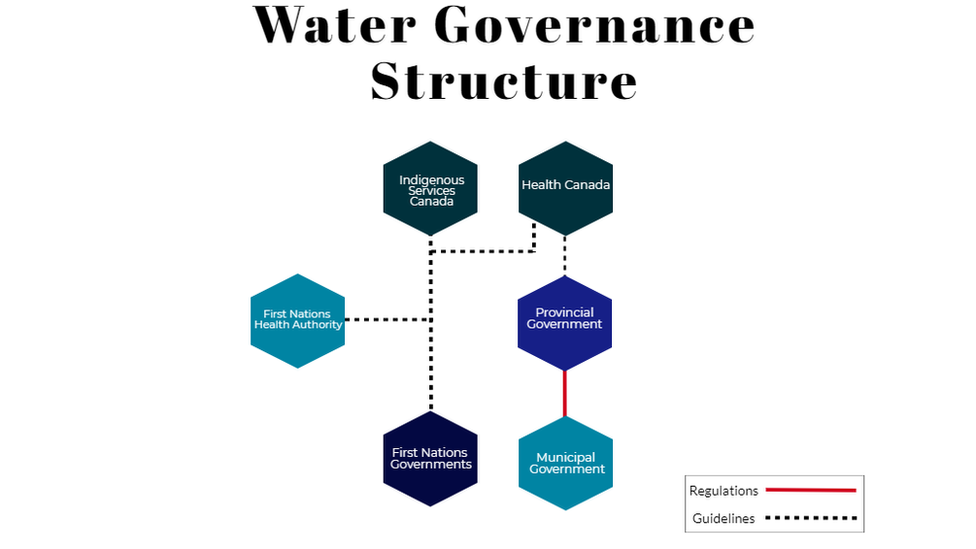
Water governance is for First Nations is the responsibility of the federal government
In March 2016, the Trudeau government announced new commitments and funds to end all long-term water advisories by 2021.
It's not the first time the government has pledged money to address these issues.
Past investments involving billions of dollars failed to produce lasting results. The lack of binding water quality regulations coupled with erratic funding, insufficient infrastructure and degraded water sources have led to systemic problems with drinking water on reserves.
Under the current structure, the federal government holds the purse strings for water systems on reserves.
When Lytton's aging Nickeyeah Creek water facility could no longer provide safe drinking water, they submitted an upgrade proposal, as required, to Indigenous and Northern Affairs Canada, the federal department previously responsible for services in Indigenous communities.
It was subsequently replaced by Indigenous Services Canada (ISC) by the Trudeau government.
Their proposal was rejected for not being "cost effective".
An engineering firm had quoted Lytton C$1.3m (£780,000) for the work - too much, the department decided, for a facility that only serviced six houses.
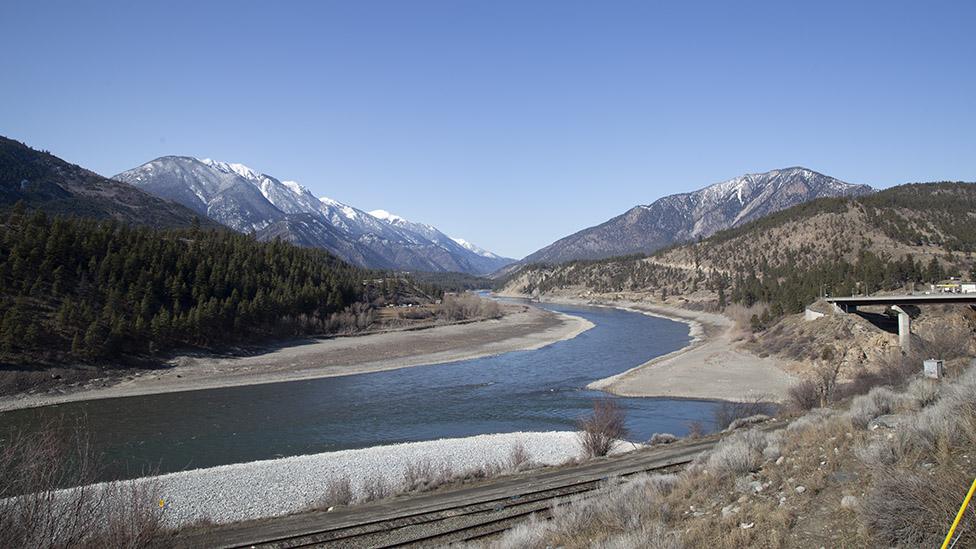
Lytton, British Columbia
Warren Brown and his uncle Jim Brown, Lytton's previous water operator for 35 years, were determined to get safe drinking water for their community.
A tall man with a wry smile, Jim connected with RES'EAU-WaterNet, a research network at the University of British Columbia which specialises in small, affordable water systems.
The network conducted a year-long study on the facility, consulting with water operators and community members.
Because of the large distances between facilities and a small number of staff, communities like Lytton require a creative approach, explains Dr Majid Mohseni, scientific director at RES'EAU.
RES'EAU decided to build a new facility altogether.
The facility was designed to be smaller, low on maintenance and to fit inside a shipping container - all for the price of C$500,000.
When the water system was completed in 2015, the community had a celebration.
"I told the guys nobody can bring bottled water, we're drinking water right out of this [facility]. And we did," says Jim Brown.
Karen Dunstan's house is one of the six serviced by the new facility. For the first time in her life, she no longer has to boil her water.
"Having clean drinking water from the tap is a blessing," says Dunstan.
Even with the new treatment plant, Lytton's water problems were far from solved.
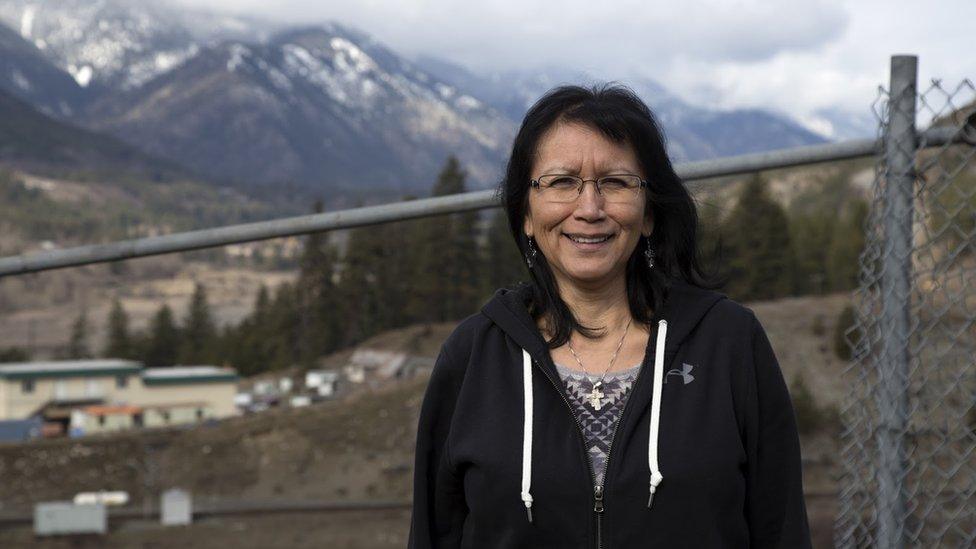
Karen Dunstan boiled the water she used for over two decades
While ISC is responsible for providing clean drinking water in Indigenous communities, there's a catch. It only considers groupings of five households or more as eligible for funding.
When Lytton's reserves were created, the government assigned them a patchwork of 56 parcels of land, some more than 100 km (62 miles) apart. Many of these reserves have fewer than five houses.
"I think water should be the right of all our people, regardless of how many people are living on a certain reserve," says Warren Brown.
Lytton resident Ted Phillips' home got clean water in 2016
Ted Philips, 48, lives on a reserve with only three houses. He's been drinking untreated water his whole life.
"We were told it wasn't good but we drank it regardless," says Philips.
"We were just never told or we never knew any better."
Warren and RES'EAU had to come up with a new solution to bring clean water to Lytton's more isolated houses, such as Philips'.
They developed a Point-of-Entry (PoE) system that treats water as it enters each home and costs C$10,000 per unit. So far, five homes have been fitted with one.
Lytton was fortunate to have strong local leadership and the help of RESEAU's technology and expertise, and 11 houses now have clean water.
But 13 houses across several reserves are required to boil or haul water, their water sources too unreliable to support a PoE.
Across Canada, the situation remains worse for many other Indigenous communities.
The success found in Lytton is something Mohseni believes is scalable to a national level.
"I think there is great potential," he says.
"I think it's a sustainable way of ensuring that these boil water advisories are lifted and, more importantly, remain lifted."
National Water Concerns
Grassy Narrows, an Ontario First Nation, has lived under 'do not consume' advisories since 2013, a result of industrial pollution that contaminated their water with mercury throughout the 1960s and 70s. One research report suggested 90% of residents experience the debilitating effects of mercury poisoning.
In neighbouring Manitoba, Shoal Lake 40 First Nation was cut off from its traditional source of clean drinking water in the early 1900s, with waterways diverted to provide water to the province's capital city.
Since their advisory was put in place more than 20 years ago, the First Nation of 71 residents has been forced to import bottled water at an annual cost of C$100,000.
While the number of boil water advisories has decreased since the government's promise, dozens of new advisories have been called.
A recent report from the David Suzuki Foundation, external, an environmental advocacy organisation, highlighted many of the challenges in achieving the target.
Many are centred around one issue: Indigenous communities do not receive enough education, training and support when it comes to water management.
The government insists it is "firmly on track" to meet the 2021 target.
"We are following this very closely with meticulous detail to have exact timelines and targets for every one of the long-term drinking water advisories that are still in place," Minister of Indigenous Services Jane Philpott says.
Warren says if Lytton is going to continue its success, it needs to work hard to maintain its water systems.
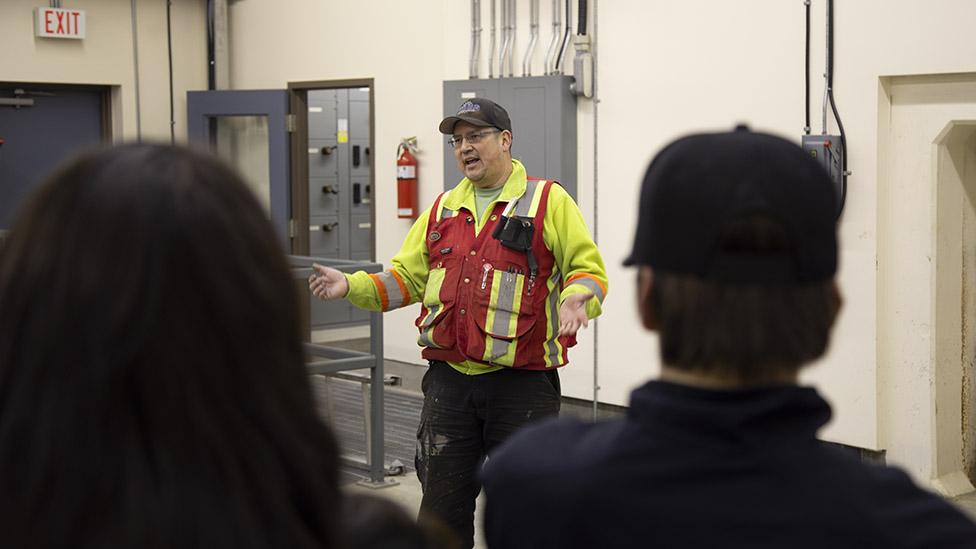
Warren Brown hopes youth will develop an interest in where their water comes from
He is looking for long-term solutions within his community, beyond government-set timelines and targets.
Warren spends time training young water operators, and even conducts water facility tours for school groups, in the hope of enticing kids into the profession from an early age.
He knows it's not an easy job, and one that requires dedication.
The job bears the intimate responsibility of shaping a community's relationship to their water. It means protecting and providing a kind of normal that is often taken for granted: the taste, smell, and clarity of safe drinking water.
"When I first started this job, I always just turned the tap on and the water was there. I never bothered to understand where it came from," says Warren Brown to a tour group from a local school.
He conducts these tours regularly, encouraging youth to think about where their water comes from - but, more importantly, to find the next generation of water operators.
Written, filmed and edited by Sharon Nadeem, Joanne Pearce, Andrew Seal, Marc Attallah, Amelia Duggan, Yannick Gayama, and Farah Kashaf. Production assisted by Peter Klein, Kim Frank, and Moura Quayle.
- Published29 November 2017

- Published29 July 2017

- Published12 May 2014
